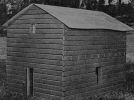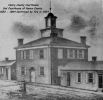A. D. Ogborn, 1902 New Castle Democrat
With such a subject one would naturally turn to the earliest recorded history of the public affairs of the county. Because that was a time when history was being made very rapidly; and the first thing likely to attract the attention of the investigator would be the original courthouse, jail and pound or stray pen. Although their story has already been told in a few years and in a permanent manner, I cannot refrain from drawing a brief picture of the public square after they were first built. The courthouse, if built where it was specified to be located, was located almost opposite the northeast corner of the Masonic Temple. It was a palatial log building, twenty-six by twenty feet in size outside, two stories high, with a puncheon floor below and a tight plank floor above. The courtroom, which was on the lower floor, was provided with benches for the spectators. The court was shut off from the crowd by a heavy banister four feet high with a strong rail on top, which had a gate three feet wide in the center, which closed on the inside and was made fast with a heavy bolt. The contract provided that the building should be "well daubed and chucked, and covered with good oak boards confined with sufficient weight poles." The contract to erect this building was let to George Barnard, May 14, 1823, and required him to complete it by the second Monday in February 1824. The contract price was two hundred and forty-seven dollars. The jail was a substantial log fortress, fourteen feet square with a heavily barred door and grated windows one foot square and two cell rooms across the west-side. The contract for the jail was let at the same time as that of the courthouse, and it was to be built east of the courthouse. The pound, or stray pen, was an enclosure forty feet square on the southwest corner of the public square and was constructed with old-fashioned post and rail fence. The records do not disclose anything as to the digging of the first public well on the public square, which was near the southwest corner of the present courthouse. But at the Commissioner's Court, September term, 1825, Isaac Bedsaul who was then treasurer of the county, was authorized by the board to contract with some person to wall the well with brick at least eight feet from the bottom, build a curb from the top of the brick wall to a point three feet above the top of the ground and, "to fix a sweep and a bucket." Fifteen dollars was appropriated for the expense of this. Thus equipping our first water works plant.
|


 Henry County Genealogical Services
Henry County Genealogical Services



